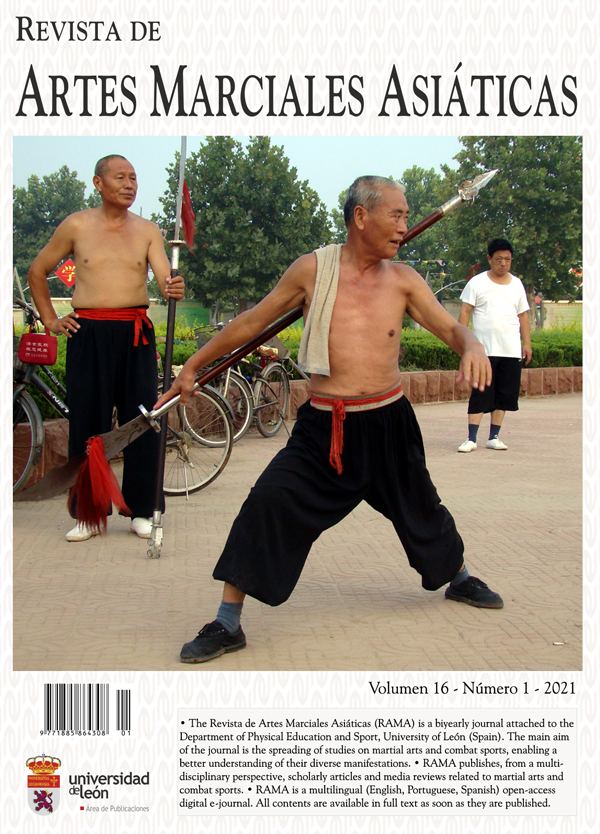Forbidden actions in World Judo Championships: differences between winner and non-winner athletes
DOI:
https://doi.org/10.18002/rama.v16i1.6865Keywords:
Combat sports, martial arts, judo, performance analysis, match analysis, judo competitionAgencies:
The authors received no funding for this work.Abstract
Penalties in judo result from negative actions that are not in line with judo combat regulations. The aim of the research was to determine the differences in penalties between winner and non-winner competitors in judo. A total of 1799 (men=1133 and women=666) matches with penalties were evaluated during 2017, 2018 and 2019 World Judo Championships. The variables were expressed as proportions and compared with the Chi-Square test with pairwise Z-tests. The ratio of receiving the first and second shido was the same in men and women athletes (p>.05), but it was different for weight categories (p<.05). The ratio of shido penalty was different between winner and non-winner athletes, the ratio of the second shido was lower in winner athletes (p<.05). While the ratio of forbidden action was the same in winner and non-winner athletes (p>.05), the ratio of forbidden actions in the first and second shido differed (p<.05). The difference in the penalty ratios in winner and non-winner athletes, especially the difference in forbidden actions leading to first and second shido may reflect some tactical differences. The results of this research can significantly contribute to the understanding of the significance of judo penalties both in training and in competition, as well as to the further study of judo penalties.
Downloads
Métricas alternativas
References
Adam, M., & Sterkowicz-Przybycień, K. (2018). The efficiency of tactical and technical actions of the national teams of Japan and Russia at the World Championships in Judo (2013, 2014 and 2015). Biomedical Human Kinetics, 10(1), 45-52. doi: 10.1515/bhk-2018-0008
Balafoutas, L., Lindner, F., & Sutter, M. (2012). Sabotage in tournaments: Evidence from a natural experiment. Kyklos, 65(4), 425-441. doi: 10.1111/kykl.12000
Balci, Ş. S., & Ceylan, B. (2020). Penalties in judo: the impact of shido on match durations and results. International Journal of Performance Analysis in Sport, 20(4), 659-667. doi: 10.1080/24748668.2020.1775413
Calmet, M., Pierantozzi, E., Sterkowicz, S., Challis, B., & Franchini, E. (2017a). Rule change and Olympic judo scores, penalties and match duration. International Journal of Performance Analysis in Sport, 17(4), 458-465. doi: 10.1080/24748668.2017.1350489
Calmet, M., Pierantozzi, E., Sterkowicz, S., Takito, M. Y., & Franchini, E. (2017b). Judo rules: searching for a wind of changes. International Journal of Performance Analysis in Sport, 17(6), 863-871. doi: 10.1080/24748668.2017.1405612
Ceylan, B., & Balcı, Ş.S. (2017). The impact of new rule changes in Judo: A comparison of points and penalties during Grand Slam Paris between 2016 and 2017. Int J Adv Sport Manag, 2, 91-4.
Doppelhammer, F., & Stöckl, M. (2020). Effects of the 2017/18 rule changes in fight duration, fight decisions, scores, penalties, and attempts in judo, based on systematic competition analysis of the World Championships 2015 and 2018. International Journal of Performance Analysis in Sport, 20(6), 1061-1071. doi :10.1080/24748668.2020.1827565
Escobar-Molina, R., Courel, J., Franchini, E., Femia, P., & Stankovic, N. (2014). The impact of penalties on subsequent attack effectiveness and combat outcome among high elite judo competitors. International Journal of Performance Analysis in Sport, 14(3), 946-954. doi: 10.1080/24748668.2014.11868770
Franchini, E., Sterkowicz, S., Meira Jr, C. M., Gomes, F. R. F., & Tani, G. (2008). Technical variation in a sample of high level judo players. Perceptual and Motor Skills, 106(3), 859-869. doi: 10.2466/pms.106.3.859-869
Franchini, E., Takito, M. Y., & Calmet, M. (2013). European Judo Championships: impact of the new rule changes on points and penalties. International Journal of Performance Analysis in Sport, 13(2), 474-479. doi: 10.1080/24748668.2013.11868663
Gutiérrez-Santiago, A., Gentico-Merino, L. A., & Prieto-Lage, I. (2019). Detection of the technical-tactical pattern of the scoring actions in judo in the men’s category of–73 kg. International Journal of Performance Analysis in Sport, 19(5), 778-793. doi: 10.1080/24748668.2019.1655934
IJF – International Judo Federation. (2013, 2016, 2017, 2018, 2020 versions). Sports and Organization Rules of the International Judo Federation Edition. Retrieved from https://www.ijf.org (accessed 24 January 2021)
IJF – International Judo Federation. Clean judo (14 January 2021). Retrieved from https://www.ijf.org/cleanjudo/480
Katicips, L. F. G., Júnior, J. N. S., Kons, R. L., & Detanico, D. (2018). Impact of different judo rules: analysis of scores and penalties in Paris Grand Slam Championships. [Impacto de las diferentes reglas de judo: análisis de puntuaciones y penalizaciones en los Campeonatos de Grand Slam de París]. RICYDE. Revista Internacional de Ciencias del Deporte. doi: 10.5232/ricyde, 14(54), 334-343. doi: 10.5232/ricyde2018.05404
Kim HY. (2017) Statistical notes for clinical researchers: Chi-squared test and Fisher's exact test. Restor Dent Endod. 42(2):152‐155. doi: 10.5395/rde.2017.42.2.152
Kons, R. L., Júnior, J. N. D. S., Fischer, G., & Detanico, D. (2018). Olympic and Paralympic Games Rio 2016: A technical-tactical analysis of judo matches. Kinesiology, 50(2), 204-210. doi:10.26582/k.50.2.7
Samuel, R. D., Basevitch, I., Wildikan, L., Prosoli, R., & McDonald, K. (2020). Please stop changing the rules! the modifications of judo regulations as a change-event in judokas’ and coaches’ careers. Sport in Society, 1-21. doi: 10.1080/17430437.2019.1669911
Downloads
Published
How to Cite
Issue
Section
License
Copyright (c) 2021 Bayram Ceylan, Husnija Kajmovic, Safet Kapo, Ekrem Colakhodzic, Sukru Serdar Balci

This work is licensed under a Creative Commons Attribution-NonCommercial-ShareAlike 4.0 International License.
The authors who publish in this journal must agree to the following terms:
- The authors grant on a nonexclusive basis the exploitation rights (reproduction, distribution, public communication and transformation) of the work accepted for publication to the University of León. The authors can establish, on their own, additional agreements for the non-exclusive distribution of the version of the work published in the journal (for example, placing it in an institutional repository or publishing it in a book), always acknowledging the initial publication in this journal.
- This work is licensed under the Creative Commons Attribution-NonCommercial-ShareAlike 4.0 International License. Click to see basic information and the legal text of the license.
- The authors are allowed and encouraged to disseminate electronically pre-print or post-print versions of their work before publication, as this can give rise to productive exchanges, as well as earlier and increased citing of the works published.











